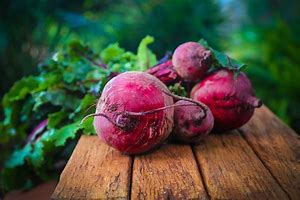
Packed with vitamins and nutrients, beetroot is a great ally against cholesterol due to its high antioxidant content and helps with weight loss.
Beetroot is a true nutrient and vitamin bomb with countless properties that should elevate it to the top of our shopping list. However, this vegetable from the Chenopodiaceae family is far less popular than it should be. In Spain, beetroot is often used to brighten up salads, and numerous studies have identified it as the perfect companion for living longer and better. Considered by many to be one of the so-called superfoods, consuming it provides numerous health benefits: weight loss, regulating blood pressure, improving intestinal transit due to its high fiber content, boosting physical strength, and preventing diseases such as dementia or cancer.
Its immense antioxidant power keeps bad cholesterol at bay and, therefore, reduces blood pressure. But its benefits don't stop there. The amount of iron and vitamin C in beetroot stimulates the production of red blood cells, combating anemia. It also regulates uric acid levels due to its alkalizing effect and high mineral content, and it acts as a laxative and lipid-lowering agent thanks to its significant fiber content. The Spanish Nutrition Foundation (FEN) also highlights that its folate content is essential for normal cell development.
Elite athletes are familiar with the miracle of beetroot, which provides positive benefits for their performance and increases blood flow thanks to the nitric oxide it contains. This same property is responsible for its positive effects against degeneration associated with dementia and other cognitive disorders, such as Alzheimer's disease. Moreover, the folic acid in this vegetable protects against the loss of brain cells in the hippocampus, the area of the brain linked to memory, and aids in the repair of damaged DNA.
Research tends to classify beetroot as an anti-cancer vegetable due to its content of betaine, the compound responsible for its characteristic red color. Betaine is a flavonoid that helps prevent certain types of cancer and, combined with antioxidants, eliminates free radicals. While caution is needed since more conclusive studies are lacking, some trials suggest that beetroot could reduce the size of certain tumors. Indeed, the Spanish Association Against Cancer recommends it as one of their staple foods.
Nutritional Value of Beetroot
The nutritional value per 100 grams of beetroot is as follows:
- Calories: 46 kcal
- Sugars: 6.75 g
- Fiber: 2.8 g
- Total fats: 0.17 g
- Cholesterol: 0 g
- Vitamin C: 4.9 mg
- Proteins: 1.61 g
- Calcium: 16 mg
- Magnesium: 23 mg
- Phosphorus: 40 mg
- Potassium: 325 mg
- Sodium: 78 mg
Varieties of Beetroot
These are the most commonly cultivated varieties of beetroot in Spain:
- Red Beetroot or Common Beetroot: The most typical in supermarkets. Its color ranges from pinkish to purplish and reddish-orange to brown, but its flesh is usually dark red, sometimes with white concentric circles. There are three types depending on the shape of their roots: spherical or globe-shaped (round), long (elongated), and intermediate.
- White Beetroot: A variety rich in sugars, with a very sweet flavor and a whitish color, distinct from the common variety.
- Sugar Beet: Has a fleshy, white, elongated root. It is grown for sugar production due to its high sucrose content and is the second-largest source of sugar in the world, after sugarcane. Regions like Castilla y León, Andalusia, the Basque Country, La Rioja, and Navarre grow an average of 80,000 tons annually, according to the Ministry of Agriculture.
- Fodder Beet: Primarily used as livestock feed due to its high energy value and good protein content. It has approximately the same energy as wheat or corn but is typically half the price of cereals.
How to Prepare Beetroot
In Spain, the root is the most commonly consumed part, but its leaves are also an ideal addition to salads. Whether served cold or hot, beetroot pairs wonderfully with meats and fish, is great for sauces, and can be used to make unique soups. Eating it raw can be harder to digest, so it's recommended to cook it for easier digestion, or buy it pre-cooked in preserves available in all supermarkets.
If you choose to cook it yourself, select beets of the same size to ensure even cooking. Remove stems and leaves, wash them thoroughly (without peeling), and cut them into equal pieces. Submerge them in boiling water with salt or sugar, and cook for no more than 20 minutes. To ensure they're done, pierce them before removing them from the water to check their softness.
Once removed from the heat, you can place them in cold water and peel them after 5 minutes for easier handling. Beetroot is also a star ingredient in detox juices and smoothies. Combined with carrots and cucumbers, which enhance its purifying properties, it makes a perfect fat-burning juice. Mixed with pear, lemon juice, and water, it helps eliminate toxins.

